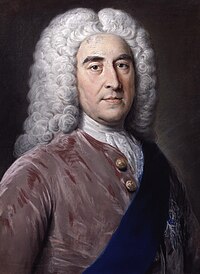Pitt–Newcastle ministry

 Pitt (top) and Newcastle (bottom)
Pitt (top) and Newcastle (bottom)
Between 1757 and 1762, at the height of the Seven Years' War, the Pitt–Newcastle ministry governed the Kingdom of Great Britain. It was headed by Thomas Pelham-Holles, 1st Duke of Newcastle, serving in his second stint as prime minister. The most influential and famous minister, however, was William Pitt the Elder, Secretary of State.
History
The ministry ended a period of political instability in which Great Britain had struggled in the war. Pitt was a strong war leader but lacked the support in Parliament necessary to provide effective leadership. Newcastle provided this, as he had a solid support base in the House of Commons. They divided duties between each other; Pitt directed the defence and foreign policies, while Newcastle controlled the nation's finances and patronage.
The ministry led Britain to many victories in the war, particularly in the so-called Annus Mirabilis of 1759, which put the country in a strong position by 1761; that year, however, Pitt resigned over a dispute concerning the entry of Spain into the war. Since King George II died in 1760, the ministry had been under pressure by the accession of George III, who disliked both Pitt and Newcastle and favoured John Stuart, 3rd Earl of Bute. Bute, a Tory, was made Northern Secretary in March 1761, and following Pitt's resignation, the ministry is otherwise referred to as the Bute–Newcastle coalition.
In 1762 Newcastle was forced to resign, with his followers (the "Pelhamites") dismissed by Bute in what became known as the "Massacre of the Pelhamite Innocents"; this is traditionally considered to have been the moment the ministry collapsed.
Ministry
It is unclear who was a member of the Cabinet.
See also
- 11th Parliament of Great Britain
- 1761 British general election
- Great Britain in the Seven Years' War
- Whigs (British political party)
Notes
- Cook & Stevenson 1980, p. 11 [REDACTED]
- Cook & Stevenson 1980, p. 12 [REDACTED] ; Namier & Brooke 1985, p. 539
- Roberts, Roberts & Bisson 2016, p. 311 [REDACTED] ; Kelch 1974, p. 178 [REDACTED]
- Bloy, Marjorie (12 January 2016), "The Massacre of the Pelhamite Innocents", A Web of English History, retrieved 16 August 2017
- Middleton 1985, p. 209
- Haydn 1851, p. 112

- Haydn 1851, p. 168

- Haydn 1851, p. 105

- Haydn 1851, p. 119

- Haydn 1851, p. 147

- ^ Haydn 1851, p. 172

- Haydn 1851, p. 192

- Haydn 1851, p. 160

- Haydn 1851, p. 401

- Haydn 1851, p. 206

- Cook & Stevenson 1988, p. 45 [REDACTED]
- Haydn 1851, p. 209

References
- Browning, Reed (2004), "Holles, Thomas Pelham-, duke of Newcastle upon Tyne and first duke of Newcastle under Lyme (1693–1768)", Oxford Dictionary of National Biography (online ed.), Oxford University Press, doi:10.1093/ref:odnb/21801 (Subscription or UK public library membership required.)
- Cook, Chris; Stevenson, John (1980), British Historical Facts, 1760–1830, Springer (published 2016), ISBN 978-1-137-06465-3
- ——; Stevenson, John (1988), British Historical Facts: 1688–1760, Palgrave Macmillan UK, ISBN 978-1-349-02369-1
- Haydn, Joseph (1851), The Book of Dignities, London: Longmans, Brown, Green, and Longmans
- Kelch, Ray A. (1974), Newcastle; A Duke Without Money: Thomas Pelham-Holles, 1693–1768, University of California Press, ISBN 978-0-520-02537-0
- Middleton, Richard (1985), The Bells of Victory: The Pitt-Newcastle Ministry and the Conduct of the Seven Years' War, 1757–1762, Cambridge University Press, ISBN 0-521-26546-0
- Namier, Lewis; Brooke, John, eds. (1985), The House of Commons, 1754–1790, Boydell & Brewer, ISBN 978-0-436-30420-0
- Roberts, Clayton; Roberts, David F.; Bisson, Douglas (2016), A History of England, Volume 2: 1688 to the Present, Routledge, ISBN 978-1-315-50960-0
| Preceded byCaretaker ministry | Government of Great Britain 27 June 1757 – 26 May 1762 (1757-06-27 – 1762-05-26) |
Succeeded byBute ministry |
